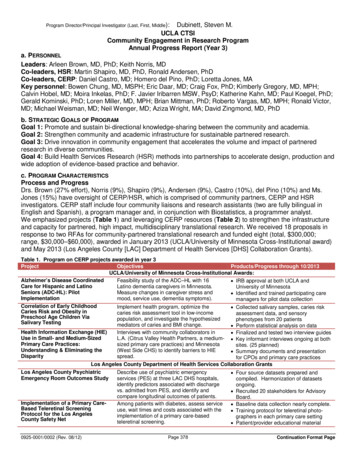
Transcription
Program Director/Principal Investigator (Last, First, Middle):Dubinett, Steven M.UCLA CTSICommunity Engagement in Research ProgramAnnual Progress Report (Year 3)a. PERSONNELLeaders: Arleen Brown, MD, PhD; Keith Norris, MDCo-leaders, HSR: Martin Shapiro, MD, PhD, Ronald Andersen, PhDCo-leaders, CERP: Daniel Castro, MD; Homero del Pino, PhD; Loretta Jones, MAKey personnel: Bowen Chung, MD, MSPH; Eric Daar, MD; Craig Fox, PhD; Kimberly Gregory, MD, MPH;Calvin Hobel, MD; Moira Inkelas, PhD; F. Javier Iribarren MSW, PsyD; Katherine Kahn, MD; Paul Koegel, PhD;Gerald Kominski, PhD; Loren Miller, MD, MPH; Brian Mittman, PhD; Roberto Vargas, MD, MPH; Ronald Victor,MD; Michael Weisman, MD; Neil Wenger, MD; Aziza Wright, MA; David Zingmond, MD, PhDb. STRATEGIC GOALS OF PROGRAMGoal 1: Promote and sustain bi-directional knowledge-sharing between the community and academia.Goal 2: Strengthen community and academic infrastructure for sustainable partnered research.Goal 3: Drive innovation in community engagement that accelerates the volume and impact of partneredresearch in diverse communities.Goal 4: Build Health Services Research (HSR) methods into partnerships to accelerate design, production andwide adoption of evidence-based practice and behavior.c. PROGRAM CHARACTERISTICSProcess and ProgressDrs. Brown (27% effort), Norris (9%), Shapiro (9%), Andersen (9%), Castro (10%), del Pino (10%) and Ms.Jones (15%) have oversight of CERP/HSR, which is comprised of community partners, CERP and HSRinvestigators. CERP staff include four community liaisons and research assistants (two are fully bilingual inEnglish and Spanish), a program manager and, in conjunction with Biostatistics, a programmer analyst.We emphasized projects (Table 1) and leveraging CERP resources (Table 2) to strengthen the infrastructureand capacity for partnered, high impact, multidisciplinary translational research. We received 18 proposals inresponse to two RFAs for community-partnered translational research and funded eight (total, 300,000;range, 30,000– 60,000), awarded in January 2013 (UCLA/University of Minnesota Cross-Institutional award)and May 2013 (Los Angeles County [LAC] Department of Health Services [DHS] Collaboration Grants).Table 1. Program on CERP projects awarded in year 3ProjectObjectivesProducts/Progress through 10/2013UCLA/University of Minnesota Cross-Institutional Awards:Alzheimer’s Disease CoordinatedFeasibility study of the ADC–HL with 16 IRB approval at both UCLA andCare for Hispanic and LatinoLatino dementia caregivers in Minnesota.University of MinnesotaSeniors (ADC-HL): PilotMeasure changes in caregiver stress and Identified and trained participating careImplementationmood, service use, dementia symptoms).managers for pilot data collectionCorrelation of Early ChildhoodImplement health program, optimize the Collected salivary samples, caries riskCaries Risk and Obesity incaries risk assessment tool in low-incomeassessment data, and sensoryPreschool Age Children Viapopulation, and investigate the hypothesizedphenotypes from 20 patientsSalivary Testingmediators of caries and BMI change. Perform statistical analysis on dataHealth Information Exchange (HIE)Interviews with community collaborators in Finalized and tested two interview guidesUse in Small- and Medium-SizedL.A. (Citrus Valley Health Partners, a medium- Key informant interviews ongoing at bothPrimary Care Practices:sized primary care practices) and Minnesotasites. (25 planned)Understanding & Eliminating the(West Side CHS) to identify barriers to HIE Summary documents and presentationDisparityspread.for CPOs and primary care practicesLos Angeles County Department of Health Services Collaboration GrantsLos Angeles County PsychiatricDescribe use of psychiatric emergency Four source datasets prepared andEmergency Room Outcomes Studyservices (PES) at three LAC DHS hospitals,compiled. Harmonization of datasetsidentify predictors associated with dischargeongoing.vs. admitted from PES, and identify and Recruited 20 stakeholders for Advisorycompare longitudinal outcomes of patients.Board.Implementation of a Primary CareAmong patients with diabetes, assess service Baseline data collection nearly complete.Based Teleretinal Screeninguse, wait times and costs associated with the Training protocol for teleretinal photoProtocol for the Los Angelesimplementation of a primary care-basedgraphers in each primary care settingCounty Safety Netteleretinal screening. Patient/provider educational material0925-0001/0002 (Rev. 08/12)Page 378Continuation Format Page
Program Director/Principal Investigator (Last, First, Middle):ProjectTransition of asthma patients fromacute care at Harbor-UCLA MedicalCenter (HUMC) back to communitymanaged care organizationsIdentifying Opportunities andExamining Evidence-BasedPrograms to Improve the Health ofYouth in Los Angeles CountyObesity group visits: An innovativeprogram to deliver obesity servicesat DHS facilitiesDubinett, Steven M.ObjectivesCompare asthma control, morbidity, quality oflife (QOL) and health care expenditures inasthmatic children during the transition fromHUMC to community HMO.Examine youth truancy citation data in LACDepartment of Public Health (DPH) and LACDHS; identify diversion strategies to preventyouth from entering the juvenile justicesystem, and develop strategies to improvehealth services planning for the care of youthin probation camps.Increase the obesity group visits at MLKMACC from 10 to 30 patients per week;implement obesity groups at two other DHSfacilities via videoconference (econsults);implement a database to track BMI and A1c.Establish stakeholder group for eventualPCORI proposal.Table 2. Funding supported by CERP infrastructureFundingAgencyServing Children and Their Families (The Children's Clinic/Inkelas)Long-Term Outcomes Of Community Engagement To AddressDepression Outcomes Disparities (Wells/Jones)LA Stroke Prevention/Intervention Research Program (SPIRP)Supplemental funding (Vickrey)Magnolia Community InitiativeWalkABLE: Steps to a Better Quality of Life (MAK)Products/Progress through 10/2013 Completed 61 telephone surveys Completed 98 surveys by mail Analysis of preliminary data Key informant interviews, and review ofpolicies and protocols for process map Systematic review of evidence-baseddiversion programs/interventions Hired/trained staff to conduct interviews Extramural funding (see table 2) Increased group visits to 25 patients/wk Database to track weight and A1capproved by IRB Infrastructure in place to start econsultobesity visits at other DHS facilities Held several post-visit discussion groupsand 5 stakeholder meetingsPeriodEverychild ons) 1 2.06NINDS09/13-08/17 0.19Doris Duke Charitable Foundation 11/13-10/16Quality and Productivity12/13-07/14Commission of LA County 0.6 0.2d. MAJOR ACCOMPLISHMENTS BY GOALGoal 1: Promote and sustain bi-directional knowledge-sharing between the community and academia.CERP has collected data from five symposia (830 attendees; 82% reported increase in knowledge) and threeworkshops (33 attendees). CERP has provided 42 consultations to researchers and community partners (70%to assist with analysis, presentations, or proposals). The consultation service has expanded to include threeadditional community representatives from diverse organizations and a faculty member with dissemination andimplementation expertise. Over the past year, we have identified a trend toward increased trust in healthresearch among symposium and workshop participants, increasing from 25% to 69%.Goal 2: Strengthen community and academic infrastructure for sustainable partnered research.Infrastructure/capacity building is a component of virtually all ongoing CERP projects: the Healthy CommunityNeighborhood Initiative (HCNI), previously the 70 Block Project (described below); the Practice-BasedResearch Network (PBRN) to conduct adaptive clinical trials and quality improvement at Harbor/LA-Biomedand the DHS Ambulatory Care Network; the partnered grant-writing course (Goal 3); the Healthy AgingInitiative (Goal 4); and the HSR data analysis group’s “hot spot” analysis (Goal 4).In November 2013, the HCNI completed community asset mapping and household interviews/clinical exams(including biomarkers) with 150 African Americans and 50 Latinos. Over the next year, partnered analysis ofthe data will help to inform the design of a partnered risk-reduction intervention in South Los Angeles.Goal 3: Drive innovation in community engagement that accelerates the volume and impact ofpartnered research in diverse communities.Nine teams participated in CERP’s 12-week community-academic partnered grant writing series (faculty camefrom UCLA, CDU, and Harbor/LA Biomed) to prepare either a foundation or NIH grant. Two teams receivedextramural funding (Children’s Clinic, Inkelas; WalkABLE, Mak); remaining teams have projects under review.This year CERP launched a new Dissemination, Implementation and Improvement (DII) initiative to facilitatesustainable transfer of new knowledge to community and health system settings. The DII faculty helped to0925-0001/0002 (Rev. 08/12)Page 379Continuation Format Page
Program Director/Principal Investigator (Last, First, Middle):Dubinett, Steven M.establish a Master of Science degree in improvement and implementation science in the Fielding School ofPublic Health and will lead a regional symposium (see Goal 3 plans for coming year).CERP co-led, with UCSF, two Deliberative Community Engagement (DCE) events (one fully bilingual) forEngageUC, a project to develop an ethical, efficient, and sustainable system for obtaining, processing, andsharing biospecimens and data. Recommendations from the DCE have been presented to UC investigatorsand policy makers and have been incorporated into a randomized trial of informed consent within UC.Goal 4: Build Health Services Research (HSR) methods into partnerships to accelerate design,production and wide adoption of evidence-based practice and behavior.The CERP/HSR team has partnered with USC, LAC DHS and LAC DPH, and local aging organizations in acounty-wide program to apply and evaluate evidence-based interventions intended to promote healthy aging.The effort has attracted great interest in the county, and we are partnering with other groups seeking toimprove services for the aging population in Los Angeles. The UCLA CTSI is committing resources to at leasttwo pilot projects, possibly in partnership with the USC CTSA. We are discussing University-wide strategiesfor identifying additional resources to move these exciting efforts forward.The data analysis working group assembled data on disease burden (e.g., chronic disease “hot spots” andpreventable admissions) and resources in LA County to address health needs at the district level. In 2013these data were presented in 8 meetings (113 attendees), and a full report was distributed to stakeholders(community organizations, health plans, LAC DHS, LAC DPH, and the City of Long Beach) who used our datafor a conference, a successful grant proposal, and to disseminate to California state assembly staffers.e. OPPORTUNITIES AND CHALLENGESAn ongoing challenge is to demonstrate the long-term health impact and sustainability of CERP activities. Inresponse to External Advisory Board (EAB), we are focusing on our partnership with LAC to test innovations toimprove and increase delivery of high-quality care. In addition to the recently funded projects (above), we haveinvited Anish Mahajan (DHS) and Tony Kuo (DPH) to join CERP leadership. Also in response to EAB, we aredeveloping a logic model to demonstrate the relationship between CERP activities and population-leveloutcomes (See section g., Goal 3).f. MODIFICATIONS TO PROGRAM PLAN, ACTIVITIES OR FOCUS WITH RATIONALE: None.g. PLANS FOR COMING YEAR BY GOALGoal 1: Promote and sustain bi-directional knowledge-sharing between the community and academia.Through the Consultation Service, in Year 4 we plan to design a Community Advisory Panel (CAP) curriculumfor academic researchers, and an analogous curriculum for community representatives serving on CAPs. Wealso plan to identify a health economist who can assist the Consultation Service with requests for cost analysis.Goal 2: Strengthen community and academic infrastructure for sustainable partnered research.We will continue to work with LA County DHS and DPH on: 1) the practice-based research network (PBRN) toconduct adaptive clinical trials and quality improvement at Harbor/LA-Biomed and the DHS Ambulatory CareNetwork; 2) the DHS pilot projects; and 3) the Healthy Aging Initiative. This year we will use the logic model(Goal 3) to evaluate the strength and effectiveness of these CERP community-academic partnerships.Goal 3: Drive innovation in community engagement that accelerates the volume and impact ofpartnered research in diverse communities. In Year 4, we will use the logic model to review the products and impact of CERP activities; to identifyfeatures of successful projects; and to guide decisions about new and continued funding. We will host a regional Dissemination, Implementation and Improvement Science Symposium in March2014 to enhance the societal impact and benefits of CTSI research, increase researchers’ andstakeholders’ competitiveness for funding, and connect individuals and organizations interested in DII. We will use knowledge gained from EngageUC to conduct DCE events relevant to LAC DHS and DPH.Goal 4: Build Health Services Research (HSR) methods into partnerships to accelerate design,production and wide adoption of evidence-based practice and behavior.With funding from the California Endowment, the health data group will release city-level data in mid-2014. Aswith the health district data, this information on chronic disease patterns and health service use will supportproposals for funding, policy initiatives, and can be linked to other data sources, such as the BiomedicalInformatics Program’s LA Data Resource (LADR).0925-0001/0002 (Rev. 08/12)Page 380Continuation Format Page
Program Director/Principal Investigator (Last, First, Middle):Dubinett, Steven M.UCLA CTSIClinical and Community Research Resources ProgramAnnual Progress Report (Year 3)a. PersonnelLeaders: E Kleerup, MD (20%); D Martins, MD, MS (15%); L Raffel, MD, MS (30%); I Salusky, MD (20%); CWang, MD (27%).Co-leaders: E Ipp, MD; M Irwin, MD; C Maida, PhD; R Mathur, MD; R Mitsuyasu, MDKey personnel: L Burnes-Bolton, DrPH, RN; K Gregory, MD; L Jones, MA; L Smith, MDb. Strategic Goals of ProgramGoal 1: To broaden the scope and efficiency of clinical, translational and community research by implementingthe CCRR without walls.Goal 2: To promote collaborations across the CTSI partner institutions.Goal 3: To recruit junior professionals into careers in translational clinical researchc. Program Characteristicsc.1. ProcessThe CCRR has four Clinical and Translational Research Centers (CTRCs). Outpatient units are located atUCLA-Westwood, Los Angeles Biomedical Institute at Harbor-UCLA Medical Center (LABiomed/Harbor),Charles Drew University of Medicine and Science (CDU), and Cedars-Sinai Medical Center (CSMC). Inpatientfacilities are located at UCLA and LABiomed/Harbor. CTRC staff includes experienced research nurses,research bionutritionists, phlebotomists, clinical research coordinators, clinical nursing assistants, andrecruitment specialists. Facilities available include sample processing labs, two metabolic kitchens, two DEXAscanners, and two sleep study facilities.c.2. ProgressNew Infrastructure Initiatives. Three projects are in the initial phase of development a) Outpatient endoscopy(expected first use UCLA, Feb. 2014), b) Electrosurgical unit for minor outpatient surgical procedures (UCLA,Jan 2014), c) Lifestyle Intervention and Food Education (LIFE) project, a community-based clinical researchsite (Weingart YMCA, CDU, LABiomed/Harbor, CSMC, UCLA, Apr 2014). Two initiatives are in use by theirfirst Investigators a) Gynecologic ultrasound (UCLA, Jul 2013) b) Neuromuscular Recovery and RehabilitationCenter (UCLA Oct 2013.) Four services have been expanded to multiple protocols locally or across institutionsa) Coordinator and Regulatory Services, b) Redcap for protected health information, c) Data safety andmanagement templates, d) Walk-in phlebotomy.Collaboration and Standardization among the Four CTRCs. A minimum data set for protocol submissioninformation across sites has been developed. We are integrating site-specific service requests with the IRBapplication and implementing the ability to exchange and track information. We are in the process of postingcommon descriptions of facilities and services to the CTSI website to give investigators a clear idea of what isavailable at each site.Seed Grants. UCLA offered two cycles of seed grants this year targeted at pilot projects and phase I studies. Inthe Spring 2013 round, 6 awards were made from 11 complete applications selected from 23 letters of intent.Three of the of the awards are for pilot studies of new treatments: “Does reversal of melatonin deficiency inpatients with Type 2 diabetes leads to preservation of insulin secretion and glucose control,” “RepositioningIvermectin for the Treatment of Alcohol Use Disorders,” “The effects of vitamin D3 versus 25OHD3supplementation on serum vitamin D metabolites and markers of mineral metabolism and immune function.”Half of the awards were to mentored new investigators. The fall UCLA cycle is under review and additionalCTRC sties will join the spring 2014 cycle.Operationalizing Clinical Research. The CTRC’s continue to provide support for our many clinical andtranslational investigators. In 2013, 233 (43 CSMC, 17 CDU, 109 LABiomed/Harbor, 64 UCLA) existingresearch projects continued and 193 (13, 9, 45, 126) new protocols were initiated. For the first 11 months ofthe reporting period, an average of 754.0 (217.2, 42.7, 246.3, 247.8) outpatient visits/month were performed(annualized 9,048 per year). Control chart analysis (Fig. 1) demonstrates the stability of the overall usage(-1.9%), but an increase at CSMC and UCLA (noted by Jul), a likely increase at CDU and a decrease at0925-0001/0002 (Rev. 08/12)Page 381Continuation Format Page
Program Director/Principal Investigator (Last, First, Middle):Dubinett, Steven M.LABiomed/Harbor (May). As planned, there has been a reduction (-13.3% compared to year 1-2) in inpatientovernight stays. An average of 47.9 (28.9 LABiomed/ Harbor, 17.9 UCLA) inpatient days/month wereperformed (annualized 574.9 per year). Control chart analysis demonstrates the usage is erratic and likelydriven by individual projects (e.g., drug abuse studies with long washout stays).Cofunding. The progressiveincrease in the portion of costs paidby non-industry grants is advancingtoward our 50% target. Our concernis that this charge-back mechanismdoes not unacceptably impactutilization and young investigators.A five-year grant at UCLA funded in2013 pays 31% of the charges, but11% if the PI is a young investigator.Educational Initiatives. We havespecifically recognized theeducational role of the CTRCs forinvestigators, coordinators andpotential future investigators.d. MAJOR ACCOMPLISHMENTSGoal 1: To implement the CCRRwithout walls. The restructuring ofthe CTRCs succeeded in shiftingthe focus to outpatient researchwhile still offering support toinvestigators who require inpatientservices. Mobile nursing to nonCTRC locations in the hospitals andclinic sites has offset the 13.3%reduction in inpatient stays.Beginning in 2014, the WeingartYMCA will provide a new venue inspecific minority communities forrecruitment and clinical researchactivities. A survey has beendeployed (Dec 2013) to assess theneeds of current CTRC users(N 354) and non-users (N 362).Monthly Outpatient Visits1150Monthly Outpatient VisitsMeanUpper Control LimitLower Control LimitMean, Current Reporting Perio
Program Director/Principal Investigator (Last, First, Middle): Dubinett, Steven M. 0925-0001/0002 (Rev. 08/12) Continuation Format Page UCLA CTSI Community Engagement in Research Program . Annual Progress Report (Year 3)
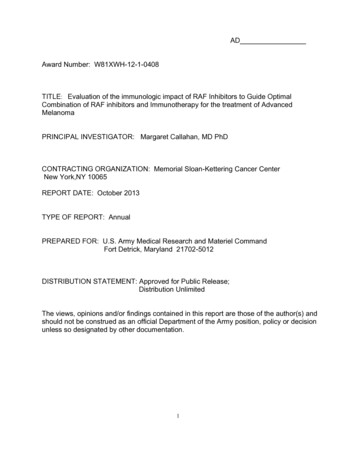
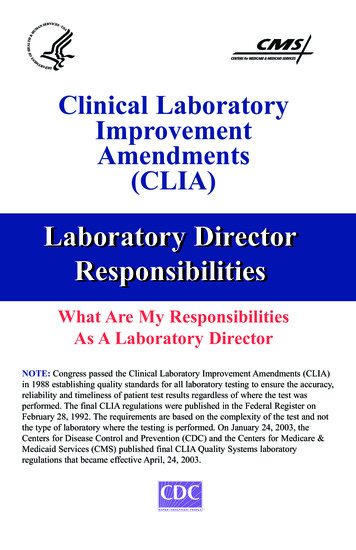



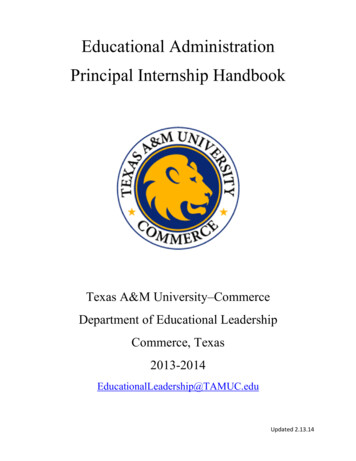
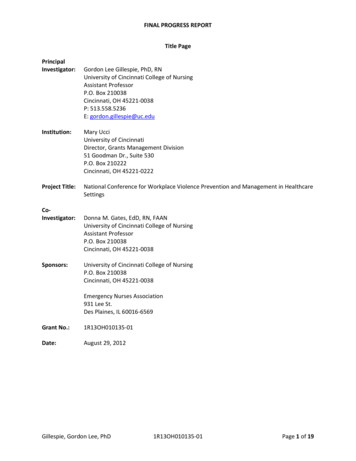
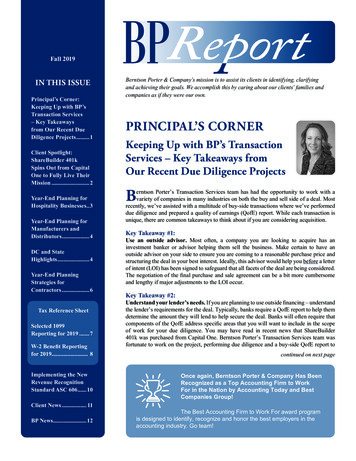

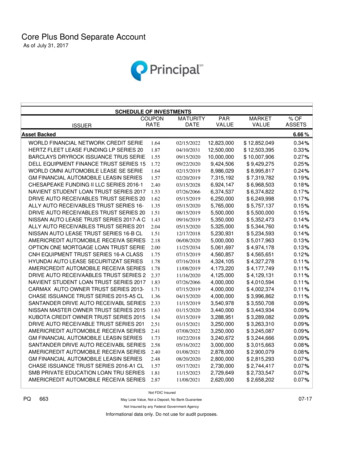
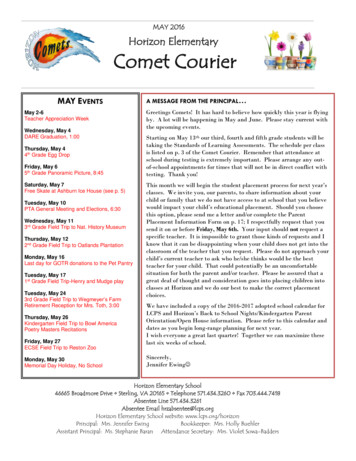
![Sample PRINCIPAL Goal TEMPLATE-April 2014[3]](/img/13/ppgessample-principal-goal-template-april-20143.jpg)